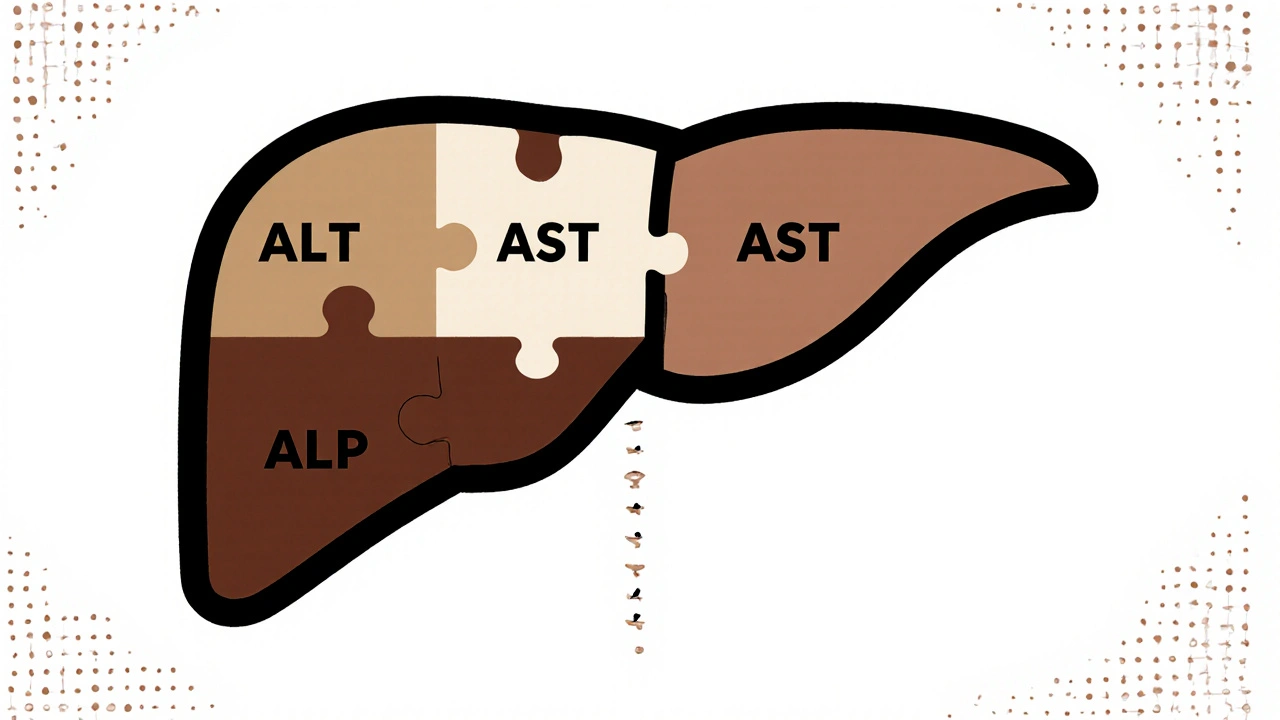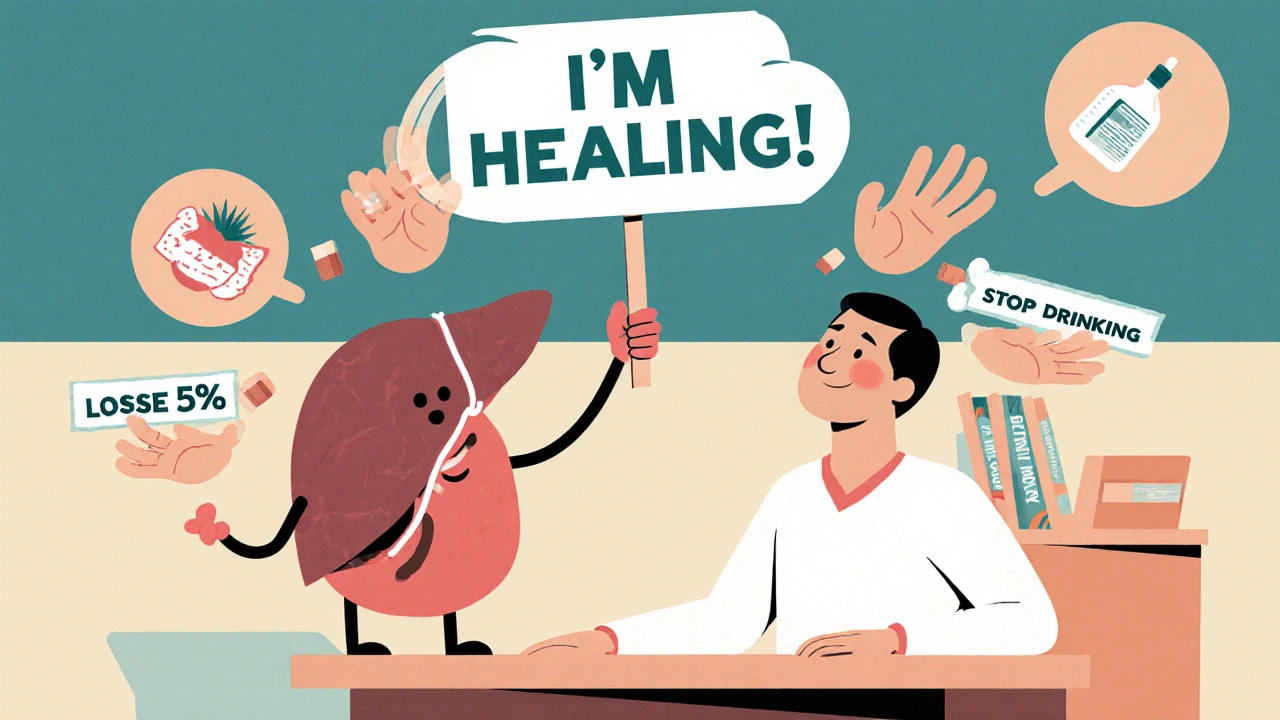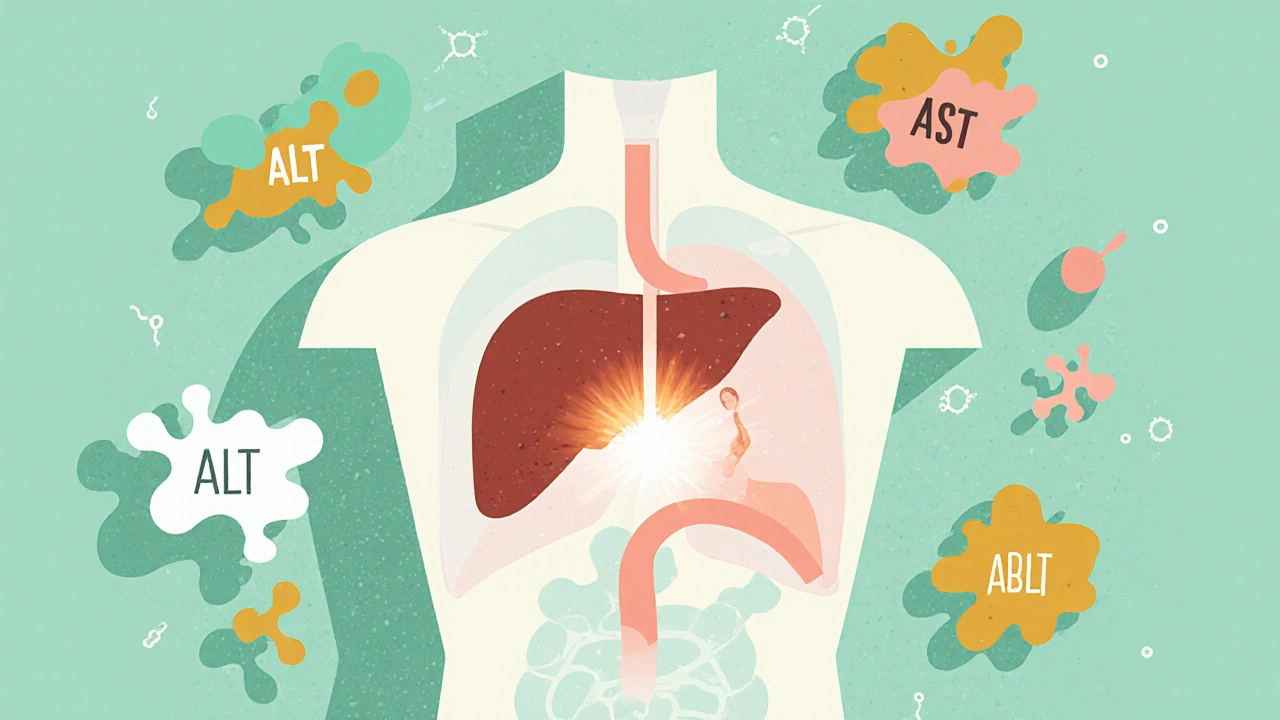When your doctor orders a liver function test, it’s not because they think your liver is broken. It’s because something in your blood is telling them to look closer. These tests don’t measure how well your liver is working like a heart measures blood flow. Instead, they spot when liver cells are damaged or when bile flow is blocked. And understanding what those numbers mean can save you from unnecessary worry-or point you toward real problems before they get serious.
What’s Actually Being Measured?
Liver function tests (LFTs) are a group of blood markers that show signs of liver stress or injury. The big four you’ll see on your lab report are ALT, AST, bilirubin, and sometimes ALP or GGT. Each one tells a different part of the story.
ALT (alanine aminotransferase) is mostly found in liver cells. When those cells get damaged-whether from virus, fat, or drug toxicity-ALT leaks into the bloodstream. It’s the most specific marker for liver injury. Normal levels range from 7 to 55 U/L, but that’s not set in stone. Men tend to have higher normal values than women. People with obesity often show levels 10-15% higher than average, even if their liver is perfectly healthy.
AST (aspartate aminotransferase) is also in the liver, but it’s found in other places too-your heart, muscles, even your kidneys. That means if your AST is high but ALT isn’t, the problem might not be your liver at all. A heart attack or intense workout can spike AST without touching ALT. Normal range is 8 to 48 U/L.
Bilirubin is a yellow pigment made when old red blood cells break down. Your liver processes it and sends it out in bile. If bilirubin builds up, your skin or eyes turn yellow-that’s jaundice. Total bilirubin levels are usually between 3 and 17 μmol/L. The key is whether it’s mostly conjugated (direct) or unconjugated (indirect). High direct bilirubin means bile flow is blocked-maybe by a gallstone or tumor. High indirect bilirubin points to too much breakdown of red cells or trouble processing bilirubin in the liver.
Albumin and prothrombin time are the only true function tests in the group. Albumin is a protein your liver makes. If levels drop slowly over months, it means your liver is struggling to produce it-common in long-term cirrhosis. Prothrombin time (PT) measures how fast your blood clots. If it’s prolonged, your liver isn’t making enough clotting factors. This can happen quickly after acute injury or slowly in advanced disease.
Patterns Matter More Than Single Numbers
One high number doesn’t tell you much. What matters is the pattern. Think of it like a puzzle. The pieces need to fit together.
If ALT and AST are both high-especially ALT more than AST-that’s a hepatocellular pattern. This means liver cells are dying. Common causes: viral hepatitis (hepatitis A or B), drug reactions (like acetaminophen overdose), or fatty liver disease. In acute viral hepatitis, ALT can jump over 1,000 U/L. In nonalcoholic fatty liver disease (now called MASLD), ALT is usually 1.5 to 2 times higher than AST.
If ALP and bilirubin are high, but ALT and AST are only slightly raised-that’s a cholestatic pattern. Something is blocking bile flow. Gallstones, bile duct scarring, or even certain medications can cause this. If ALP is high but GGT is normal, the problem might not be your liver at all-it could be your bones. ALP is also made in bone tissue, so a fracture or bone disease can trick the test.
The AST/ALT ratio is one of the most powerful clues. If AST is more than twice as high as ALT, it’s a red flag for alcohol-related liver damage. In fact, 90% of people with alcoholic hepatitis have this ratio above 1, and often above 2. If the ratio is less than 1, it’s more likely to be viral hepatitis or MASLD. But here’s the catch: if AST is over 500 U/L, alcohol alone probably isn’t the cause. Think acetaminophen overdose instead.

When Should You Worry?
Not every slightly elevated number means disease. About 10-15% of healthy people have ALT or AST levels just a little above normal-1.5 times the upper limit. That’s often just normal variation, especially if you’re overweight or physically active. A 2022 study in JAMA Internal Medicine found that nearly 4 out of 10 primary care doctors ordered unnecessary scans for ALT levels between 41 and 80 U/L. That’s overtesting.
Real red flags:
- ALT or AST above 500 U/L-especially if rising fast (more than 100 U/L per week)
- Jaundice with high bilirubin and ALP
- Low albumin and prolonged PT-signs of advanced liver damage
- ALT rising while AST falls-could mean recovery after acute injury
Chronic liver disease, like cirrhosis from years of heavy drinking or untreated hepatitis, often shows only mild or even normal enzyme levels. That’s why people don’t realize they’re damaged until it’s too late. That’s why the real test isn’t just the numbers-it’s the story behind them.
What Else Can Skew the Results?
Many things can make your liver enzymes look worse than they are:
- Medications: Antibiotics, statins, NSAIDs, and even some herbal supplements can raise ALT and AST.
- Exercise: Intense workouts can spike AST because of muscle breakdown.
- Alcohol: Even one heavy drinking session can raise levels for days.
- Thyroid problems: Can cause mild ALT elevations.
- Obesity: Increases baseline levels without actual liver damage.
Also, ALT has a half-life of about 47 hours. That means if you had a sudden injury-like a drug overdose-ALT will stay high for days, even after the damage is done. AST clears faster, so its level drops quicker. That’s why doctors look at both: if AST is falling but ALT is still high, the liver is still healing.

What Happens Next?
If your numbers are only slightly elevated and you feel fine, your doctor might just ask you to come back in 3-6 months. No need for scans or biopsies yet. They’ll check your weight, alcohol use, medications, and ask about family history.
If the pattern is clear-say, high ALT with high fat and insulin resistance-they might test for MASLD using a non-invasive score like FIB-4. A 2021 study showed that combining LFTs with FIB-4 improved detection of advanced liver scarring from 68% to 89% accuracy.
If numbers are very high or symptoms are present-jaundice, swelling, confusion-then imaging (ultrasound, MRI) or a liver biopsy might be needed. Newer blood tests like the ELF test can detect early fibrosis with 92% accuracy when paired with AST/ALT ratios, and are becoming more common in specialist clinics.
What You Can Do
You can’t fix a liver problem with a pill. But you can change your habits-and that’s often enough.
- If you drink alcohol, cut back or stop. Even small reductions help.
- If you’re overweight, lose 5-10% of your body weight. That alone can reverse fatty liver.
- Check your medications. Ask your doctor if anything you’re taking could be hurting your liver.
- Avoid unregulated supplements. Many herbal products (like green tea extract or weight-loss pills) cause liver damage.
- Get vaccinated for hepatitis A and B if you haven’t already.
The liver is one of the few organs that can regenerate. Even after years of damage, stopping the cause-like alcohol or fat buildup-can let it heal. But you have to act before the damage becomes permanent.
What does a high ALT level mean?
A high ALT level usually means liver cells are damaged. Common causes include viral hepatitis, fatty liver disease (MASLD), alcohol use, or certain medications. ALT is the most specific liver enzyme, so if it’s high and AST isn’t, the problem is likely in the liver itself.
Can AST be high without liver damage?
Yes. AST is found in muscle and heart tissue too. A heart attack, severe muscle injury from exercise, or even a prolonged seizure can raise AST without affecting the liver. That’s why doctors always compare AST to ALT-high AST with normal ALT often points to a non-liver cause.
What does a high bilirubin level mean?
High bilirubin means your body isn’t processing or removing it properly. If it’s mostly direct (conjugated) bilirubin, bile flow is blocked-think gallstones or bile duct issues. If it’s mostly indirect (unconjugated), your body is breaking down too many red blood cells or your liver can’t process bilirubin fast enough. Jaundice (yellow skin/eyes) happens when levels get too high.
Is an AST/ALT ratio over 2 always alcohol-related?
It’s a strong sign, but not always. An AST/ALT ratio above 2 is seen in 90% of alcoholic hepatitis cases. But it can also happen in acute viral hepatitis or fulminant liver failure. If AST is over 500 U/L, alcohol alone is unlikely-think drug overdose instead. Context matters: your history, symptoms, and other test results are just as important as the ratio.
Can liver function tests be normal even if the liver is damaged?
Yes. In advanced cirrhosis, liver enzymes can be normal or only slightly elevated because there are fewer liver cells left to leak enzymes. The real signs of damage at this stage are low albumin, high bilirubin, and prolonged prothrombin time. That’s why doctors look at the whole picture-not just ALT and AST.
How often should liver function tests be checked?
For healthy people, routine LFTs aren’t needed. If you have risk factors-obesity, diabetes, heavy alcohol use, or are on liver-toxic medications-your doctor might check them once a year. If levels are mildly elevated but stable, repeat testing every 3-6 months is common. Rapid changes or very high numbers require faster follow-up.

